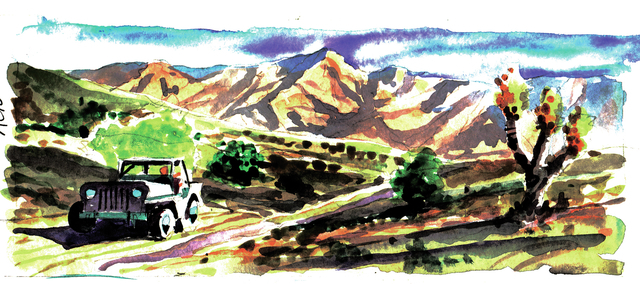Dramatic Afton Canyon a hidden oasis in the Mojave

One of those hidden beauty spots that delight desert lovers, scenic Afton Canyon lies off Interstate 15 between Baker and Barstow in Southern California.
Also known as “the Grand Canyon of the Mojave,” the rugged gorge carved by the intermittently flowing Mojave River is best suited to cool-season visitation. It appeals to off-highway explorers, campers, horsemen, rock hounds, photographers and wildlife watchers.
Follow I-15 south from Las Vegas toward Barstow. About 20 miles south of Baker, watch for a series of turnoffs, starting with Rasor Road, which accesses a nearby off-highway vehicle area. Keep driving on I-15, next passing Basin Road. Watch for the turnoff to Afton Canyon onto a graded road.
From the freeway, the road runs about 3½ miles to a small campground established near the Mojave River and the Southern Pacific Railroad tracks, which follow the water through the canyon. A sturdy railroad bridge spans the river near the campground, carrying trains that rumble across the desert several times a day — and night. The road may be used by all but the lowest-slung vehicles as far as the campground. Beyond the campground, explore marked routes using high-clearance vehicles, preferably with four-wheel drive.
The region is a complex of public and private lands administered by the Bureau of Land Management as Afton Canyon Natural Area. Because of its oasislike setting, running water, thick vegetation and wide variety of birds and animals, it has been designated an area of critical environmental concern. Efforts are ongoing to enhance the natural vegetation by eradicating exotic plant species and to control damage done by indiscriminate vehicle use.
Vehicle access is restricted to a few routes, including historic Mojave Road, a rough, four-wheel-drive trail beloved by off-roaders. Mojave Road follows in the footsteps of prehistoric native nomads, mountain men, early explorers and military expeditions. Other old trails into nearby side canyons may now be traveled only on foot or horseback. Although hiking, backpacking and primitive camping are encouraged, campfires outside of the campground area are restricted.
The modest campground provides several sites, available on a first-come basis for a fee of $6 per night. There is a 14-day limit. Each site is equipped with a parking pad, table and grill. Pit toilets are centrally located. Drinking water must be trucked to the site, so many campers bring their own, at least a gallon per person per day. Use a self-contained camp stove or bring firewood. You’ll need bags for disposing of camp refuse at home.
Because the campground lies well within the canyon, the night sky is very dark, except during bright moonlight. The site is popular for stargazing and watching celestial events such as meteor showers.
The Mojave River is one of those elusive desert streams that course underground most of their length. Along this part of the watercourse, however, the river and flooded streams have scoured the landscape down to bedrock and the water runs over the rocky surface.
Scenery in Afton Canyon is quite colorful and dramatic. The birds and desert wildlife drawn to the water and vegetation delight observers and photographers. Observation is most rewarding early or late in the day, also the best times for photography. You’ll want to bring your camera, spotting scope, binoculars and field identification guides.
The surrounding area is open to seasonal hunting under state regulations, but only with limited types of firearms and ammunition. Certain county and federal regulations apply. Hunters must be very careful about shooting on private land, which requires permission. No firearms may be discharged near the campground. Recreational shooting is not allowed within Afton Canyon Natural Area.
Margo Bartlett Pesek’s column appears on Sundays.












